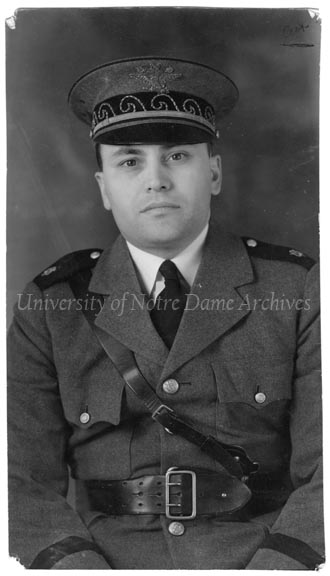
“When four rows of Glee Club singers chant a Notre Dame song; when columns of blue-uniformed bandsmen play and march to Notre Dame music — then we forget the ubiquitous campus grinds and gripers, and we hike along, down the line, cheering her name, and glad that Irish Backs are marching” [Scholastic, 03/14/1930, page 689]
Born into a musical family, Joseph Casasanta naturally became involved with the music organizations as a student at Notre Dame, holding leadership positions in the Glee Club and the Marching Band. Before he graduated in 1923, Casasanta joined the faculty in teaching piano and as an assistant director of the University Band. While music had long been taught at Notre Dame, there were no programs leading to a Bachelor of Music degree until the 1920s. It is believed that Casasanta was the first student to earn such a degree at Notre Dame.

After graduation, Casasanta remained at Notre Dame, moving up to director of the Music Department until 1942. He also led the University Band, the Glee Club, and the Orchestra; and he founded Notre Dame’s Linnets and the South Bend Symphony. Casasanta’s most enduring legacy came from the songs that he wrote for Notre Dame, many of which have been in the repertoire of the Glee Club and the Marching Band since their debuts.
Inspired by the cadence of the football team, Casasanta and his brother-in-law and Notre Dame Architect Vincent Fagan wrote Hike, Notre Dame in 1923. Scholastic reported that “About a year ago many of us felt the need of a new college song – ‘The Victory March,’ it was thought, was in danger of becoming too trite. Our constant desire to sing our appreciation of Notre Dame demanded another melody. As a result ‘The Hike Song’ was composed” [Scholastic, October 1923, page 102].
Alumni Michael and John Shea wrote the Victory March in 1908 to fill the void of a stirring Notre Dame fight song. They felt their contribution was “amateurish” and they hoped that future students would build upon their initiative to create something even better. Rev. Michael Shea recalled that “Ten years after my ordination, I heard the ‘Victory March’ for the first time while on a visit to Notre Dame. How it came to its present exalted condition, I do not know. The coming of Mr. Casasanta was evidently the realization of our hopes, and to him I express my hearty appreciation of a good work admirably done for the best University in the land” [Scholastic, 07/30/1930, page 529]. Casasanta’s arrangement of the Victory March is the basis for what the Marching Band and Glee Club still perform today.

On Down the Line came in 1925 and the students quickly embraced it in the repertoire of collegiate songs and cheers at the football games and pep rallies. The Glee Club also sang these songs at concerts, on radio broadcasts, and for recordings, which helped to solidify their national popularity.
Notre Dame, Our Mother, whose lyrics were written by University President Rev. Charles O’Donnell in March 1930, debuted at the premiere of The Spirit of Notre Dame on October 7, 1931, and was quickly adopted as the Alma Mater. At the end of the halftime show of the last football game of the 1931 season, “the people in the stands [were] requested to stand at attention for the playing of ‘Notre Dame, Our Mother,’ in memory of the late Knute Rockne” [Scholastic, 11/20/1931, page 9], and thus, another tradition began.
When the Irish Backs Go Marching By debuted in 1930 at a time when the “Fighting Irish” moniker was still somewhat influx, as Scholastic noted with tongue-in-cheek: “The dispute over ‘Irish’ as applied to our varsities seems to be at an end; the name of the song has commemorated in lyrical history the 1929 activities of those doughty Celtic side-steppers—Carideo, Schwartz, Elder, Brill, Gebert, and Mullins” [Scholastic, 03/14/1930, page 689].

Obituary of Marching Band Director Joseph Casasanta, 1968.
Notre Dame honored Casasanta at the 1932 Commencement Exercises. Deeply touched by the honor, Casasanta wrote his appreciation to University President Charles O’Donnell and said in part, “Whatever I have done, I owe all to Notre Dame. She has always been and will always be the source of all my inspiration, love, and joy” [UPCO 1/77, June 15, 1932]. Casasanta passed away in December of 1968, but his music has become an indelible part of Notre Dame’s identity and has endured throughout generations.
Sources:
Scholastic
Alumnus
UPCO
UPWL
UDIS 103/04
GDIS 2/17
UNDR 10/04
100 Years of the Notre Dame Victory March (1908-2008)
